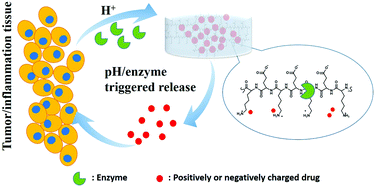Development of ionic strength/pH/enzyme triple-responsive zwitterionic hydrogel of the mixed l-glutamic acid and l-lysine polypeptide for site-specific drug delivery
Abstract
Environmentally responsive hydrogels show enormous potential in various applications, such as tissue engineering and drug delivery. The site-specific controlled drug delivery of hydrogels can improve the therapeutic outcome and minimize the negative side effects. In this work, enzymatically digestible hydrogels, which are composed of equally mixed L-glutamic acid (E) and L-lysine (K) polypeptides after being crosslinked by the coupling reaction between carboxyl groups and primary amines catalyzed by 1-ethyl-3-(3-dimethylaminopropyl) carbodiimide·HCl (EDC·HCl), were prepared to improve the biocompatibility through reducing the nonspecific protein adsorption and cell attachment. Hydrogels loaded with two model drugs, doxorubicin hydrochloride (DOX·HCl) (positively charged anti-cancer drug) and diclofenac sodium (negatively charged anti-inflammatory drug), showed accelerated complete drug release and full enzymatic degradation in the presence of trypsin, which was reported to be expressed in various carcinomas and inflammations. The drug release also responds to the pH change through tuning charge–charge interaction. These indicated that the prepared hydrogels were promising candidates for drug delivery systems.

- This article is part of the themed collection: 2017 Journal of Materials Chemistry B HOT Papers

 Please wait while we load your content...
Please wait while we load your content...